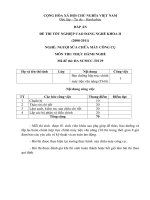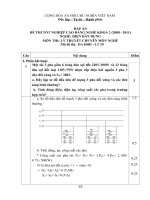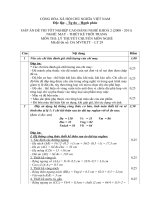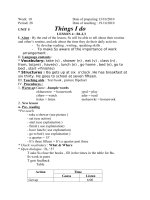29 cyclopropanation
Bạn đang xem bản rút gọn của tài liệu. Xem và tải ngay bản đầy đủ của tài liệu tại đây (1.3 MB, 11 trang )
Myers
Chem 115
Cyclopropanation
Reviews:
• Bonding Orbitals in Cyclopropane (Walsh Model):
Roy, M.-N.; Lindsay, V. N. G.; Charette, A. B. Stereoselective Synthesis: Reactions of Carbon–
Carbon Double Bonds (Science of Synthesis); de Vries, J. G., Ed.; Thieme: Stuttgart, 2011, Vol 1.;
731–817.
Lebel, H.; Marcoux, J.-F.; Molinaro, C.; Charette, A. B. Chem. Rev. 2003, 103, 977–1050.
Davies, H. M. L.; Beckwith, R. E. J. Chem. Rev. 2003, 103, 2861–2903.
Li, A-H.; Dai, L. X.; Aggarwal, V. K. Chem. Rev. 1997, 97, 2341–2372.
eS (")
• Applications of Cyclopropanes in Synthesis
eA (")
Carson, C. A.; Kerr, M. A. Chem. Soc. Rev. 2009, 38, 3051–3060.
Reissig, H.-U.; Zimmer, R. Chem. Rev. 2003, 103, 1151–1196.
Gnad, F.; Reiser, O. Chem. Rev. 2003, 103, 1603–1624.
!
• Cyclopropane Biosynthesis
Thibodeaux, C. J.; Chang, W.-c.; Liu, H.-w. Chem. Rev. 2012, 112, 1681–1709.
de Meijere, A. Angew. Chem. Int. Ed. 1979, 18, 809–886.
General Strategies for Cyclopropanation:
Introduction
• via carbenoids
"MCH2X"
H
H
HH
H
H
H
H
H
H
H
H
• via carbenes generated by decomposition of diazo compounds
RCHN2
R
• Cyclopropanes are stable but highly strained compounds (ring strain ~29 kcal/mol).
• C–C bond angles = 60º (vs 109.5º for normal Csp3–Csp3 bonds).
• Substituents on cyclopropanes are eclipsed. H–C–H angle is ~120º. As a result, the C–H bonds
have higher s character compared to normal sp3 bonds.
• via Michael addition and ring closure
RCH–LG
EWG
EWG
LG
EWG
R
• Because of their inherent strain, the reactivity of cyclopropanes is more closely analogous to that of
alkenes than that of alkanes.
R
RCH2
EWG
LG
EWG
LG
EWG
R
Lebel, H.; Marcoux, J.-F.; Molinaro, C.; Charette, A. B. Chem. Rev. 2003, 103, 977–1050.
James Mousseau, Fan Liu
1
Myers
Chem 115
Cyclopropanation
• Diastereoselective cyclopropanation is possible in the presence of directing groups:
Simmons-Smith Reaction –– Zinc Reagents in Cyclopropanation
• Original Report:
OH
OH
CH2I2, Zn(Cu)
H
CH2I2, Zn(Cu)
(±)
Et2O, 35 ºC
48%
Et2O, 35 ºC
63%
(±)
OCH3
H
CH3O
H
CH2I2, Zn(Cu)
H
Et2O, 35 ºC
~60%
(±)
(±)
H
H
Dauben, W. G.; Berezin, G. H. J. Am. Chem. Soc. 1963, 85, 468–472.
Simmons, H. E.; Smith, R. D. J. Am. Chem. Soc. 1958, 80, 5323–5324.
• Interestingly, excess carbenoid can reverse the directing effect of alcohols.
• Reaction Overview:
Zn
R1
"ZnCH2I"
R1
H
R2
OZnR'
OZnR'
H
OBn
OBn
OZnR'
H
I
CH2
H
R1
H
R2
R2
Butterfly transition state
OBn
H
Zinc Reagent
dr
yield
Zn(CH2I)2 (1 equiv)
>25:1
>95%
EtZnCH2I (9 equiv)
1:>25
>95%
Charette, A. B.; Marcoux, J. F. Synlett, 1995, 1197–1207.
• The reaction is proposed to proceed through a "butterfly" transition state.
• Directed cyclopropanation is also possible in acyclic systems:
Simmons, H. E. Org. React. 1973, 20, 1–133.
OH
OH
OH
• Zinc cyclopropanating reagents can be generated in various ways. Both Zn metal and ZnEt2 can be
used.
Et2Zn, CH2I2
CH3
CH3
CH3
CH2Cl2, –10 °C
97%
H
H
130
• Many zinc reagents for cyclopropanation have been developed:
:
1
Charette, A. B.; Lebel, H. J. Org. Chem. 1995, 60, 2966–1967.
• Diastereoselectrive cyclopropanation has been used in tandem asymmetric organozinc additions:
I
Simmons
and Smith
O
I
I
I Zn
Zn
Zn
I
H3C
Denmark
Furukawa
F3C
Zn
I
Shi
O
EtO P
EtO
Zn
1. HBEt2, PhCH3, 23 ºC
2. Et2Zn, i-PrCHO
I
Charette
Ph
General applicability
Highly reactive
carbenoid for
unreactive alkenes
Highly stable carbenoid
H3C
Ph
CH3
O
N
OH
H3C
OH
(4 mol%)
–78 ! –10 ºC
CH3
CH3
ZnEt2, CH2I2
CH2Cl2, 23 ºC
OH
CH3
Ph
H
CH3
75%, 99% ee
dr >20:1
Kim, H. Y.; Lurain, A. E.; Garcia-Garcia, P.; Carroll, P. J.; Walsh, P. J. J. Am. Chem. Soc. 2005,
127, 13138–13139.
James Mousseau, Fan Liu
2
Myers
Chem 115
Cyclopropanation
• Asymmetric Simmons-Smith Reaction Using Chiral Auxiliaries
• Stoichiometric Promoter for Asymmetric Simmons-Smith Cyclopropanation
• Allylic alcohols:
• A chiral dioxaborolane auxiliary prepared from tetramethyltartramide and butylboronic acid has
been shown to be effective in the asymmetric cyclopropanation of allylic alcohols.
• A hydrogen peroxide work-up is employed to remove boron side-products.
OBn
O
BnO
BnO
Et2Zn, CH2I2
Ph
O
OBn
OH
O
BnO
BnO
toluene, –35 ! 0 ºC
A (1.1 equiv)
Ph
O
OH
OH
98%, dr >50:1
via
OBn
O
BnO
BnO
O
Me
O Zn
EtZn
C
H2I
BnO
BnO
+
>98%, 93% ee
then 30% aq H2O2
OBn
Ph
HO
OH
0 ! 23 ºC
1. Tf2O, C5H5N
2. DMF, H2O, C5H5N
160 ºC, 90%
Me
Et
H
Zn(CH2I)2, DME, CH2Cl2
O
O
via H C
3
O
O
N(CH3)2
(H3C)2N
CHO
O
B
n-Bu
O
O
Charette, A. B.; Côté, B.; Marcoux, J.-F. J. Am. Chem. Soc. 1991, 113, 8166–8167.
B
H
A
O
O
Zn
Ph H
O
N(CH3)2
N(CH3)2
I
• Allylic amines:
Charette, A. B.; Juteau, H.; Lebel, H.; Molinaro, C. J. Am. Chem. Soc. 1998, 120, 11943–11952.
Ph
OH
H3C
N
CH3
Et2Zn, CH2I2
Ph
CH2Cl2, 0 °C
Ph
OH
H3C
N
CH3
95%, dr = 98:2
• Allylic alcohols are cyclopropanated selectively:
Ph
CH3
OH
• ",#-Unsaturated carbonyls:
H
H3C
O
2.
H3C
CO2i-Pr
O
OH
i-PrO2C
O
CO2i-Pr
CO2i-Pr
OH
H
O
H
H3C
then 30% aq H2O2
OH
80%, 95% ee
Nicolaou, K. C.; Sasmal, P. K.; Rassais, G.; Reddy, M. V.; Altmann, K. H.; Wartmann, M.; O'Brate,
A.; Giannakakou, P. Angew. Chem. Int. Ed. 2003, 42, 3515–3520.
• The cyclopropanation of allenic alcohols affords spiropentane derivatives:
hexanes, –20 °C
Et
H3C
H3C
Et2Zn, CH2I2
C5H5NH•OTs, C6H6
80 ºC, 79%
pTSA, THF
CH3
Zn(CH2I)2, DME, CH2Cl2
H3C
Aggarwal, V. K.; Fang, G. Y.; Meek, G. Org. Lett. 2003, 5, 4417–4420.
1. (EtO)3CH, NH4NO3 (cat.)
EtOH, 23 ºC
ent-A (1.1 equiv)
CH3
H3C
H2O, 65 ºC
yield not provided
O
O
OH
C
CO2i-Pr
CO2i-Pr
Et
H
A (1.1 equiv)
Zn(CH2I)2, DME, CH2Cl2
–10 ! 23 ºC
then 10% aq NaOH
OH
MO
Et
Et
Et
H
H
Et
70%, 97% ee
90%, dr = 97:3
Mash, E. A.; Nelson, K. A. J. Am. Chem. Soc. 1985, 107, 8256–8258.
Mori, A.; Arai, I.; Yamamoto, H. Tetrahedron 1986, 42, 6447–6458.
Charette, A. B.; Jolicoeur, E.; Bydlinkski, G. A. S. Org. Lett. 2001, 3, 3293–3295
James Mousseau, Fan Liu
3
Myers
Chem 115
Cyclopropanation
• The dioxaborolane promoter can be used to prepare 1,2,3-trisubstituted cyclopropanes.
• Unfunctionalized alkenes can undergo asymmetric Simmons–Smith cyclopropanation in presence of
a valine/proline dipeptide.
• In the example shown, the intermediate borinate was used directly for Suzuki coupling:
• Selectivity is higher for trisubstituted alkenes than for disubstituted alkenes.
O
O
(H3C)2N
Ph
OH
1. Et2Zn
CH2Cl2, 0 ºC
Ph
OZnEt
2. A (1.2 equiv)
N(CH3)2
O
Ph
O
B
C (1.25 equiv)
Ph
O
n-Bu
ZnEt
H
Ph
H
O
n-Bu
B
B-Zn Exchange
O
4. Pd(PPh3)4
(5 mol%)
CH2Cl2, –78 ! –40 ºC
Ph
H3C
N
CH3
C
absolute stereochemistry
not reported
Long, J.; Yuan, Y.; Shi, Y. J. Am. Chem. Soc. 2003, 125, 13632–13633.
• Catalytic Enantioselective Simmons-Smith Cyclopropanation Reactions
• Chiral bis-sulfonamides have been used to direct asymmetric Simmons–Smith reactions of allylic
alcohols:
Ph
PhI, KOH
THF, 65 ºC
0 ºC, CH2Cl2
83%, 90% ee
CO2CH3
O
B
n-Bu
O
ZnEt
Ph
Et2Zn, CH2I2
BocHN
3. EtZnI•OEt2, CHI3
N(CH3)2
O
H
O
(H3C)2N
ZnI
O
Ph
OH
D (10 mol %)
59%, 92% ee, >20:1 dr
OH
Et2Zn, ZnI2, Zn(CH2I)2
NHSO2CH3
OH
CH2Cl2, 0 ºC
92%, 89% ee
Zimmer, L. E.; Charette, A. B. J. Am. Chem. Soc. 2009, 131, 15624–15626.
NHSO2CH3
D
• Homoallylic ethers can be cyclopropanated using a zinc phosphate, prepared in situ from a chiral
phosphoric acid:
OBn
B
B (1.2 equiv)
Et2Zn, CH2I2
OBn
CH2Cl2, 0 ºC
85%, 93% ee
Denmark, S. E.; O'Connor, S. P. J. Org. Chem. 1997, 62, 584–594.
• "Taddolates" can also be used:
E
via
Ar
Ar =
E (25 mol %)
Ar
O
O
P
O
OH
O
O
P
O
OZnCH2I
Ar
Ar
OH
Zn(CH2I)2, 4Å MS
CH2Cl2, 0 ºC
85%, 92% ee
OH
Et
Et
O
O
Ph
Ph
Ph
O
i-PrO
Ti
O
Ph
Oi-Pr
Charette, A. B.; Molinaro, C.; Brochu, C. J. Am. Chem. Soc. 2001, 123, 12168–12175.
Lacasse, M.-C.; Poulard, C. Charette, A. B. J. Am. Chem. Soc. 2005, 127, 12440–12441.
James Mousseau, Fan Liu
4
Myers
Chem 115
Cyclopropanation
• A bifunctional Al-complex is an effective cyclopropanation catalyst and is believed to bind both the
Zn and the allylic alcohol:
ligand (10 mol%)
Et2AlCl (10 mol%)
TBDPSO
OH
H3C
TBDPSO
I
TMS
CH3
CO2Et
1. LiTMP, HMPA
THF, toluene, –95 ºC
2.
ligand
TMS
CO2Et
O
O
NH
via
Te+
OH
Et2Zn, CH2I2
CH2Cl2, 23 ºC
99%, 90% ee
• Telluronium ylides can also be used:
81%, 97% ee
N
OH HO
Ph Ph
O
Zn N Al N
O
O Cl
ZnEt
Liao, W.-W.; Li, K. Tang, Y. J. Am. Chem. Soc. 2003, 125, 13030–13031.
• Camphor-derived sulfur ylides can be employed for stereoselective cyclopropanations of Michaelacceptor olefins:
Shitama, H.; Katsuki, T. Angew. Chem. Int. Ed. 2008, 47, 2450–2453.
Cyclopropanation via Michael Addition and Ring Closure –– Asymmetric Cyclopropanation
Through Chiral Ylides
• In an early report, optically enriched oxosulfonium F was prepared in 3 steps, which
stereoselectively cyclopropanates Michael-acceptors:
O
H3C
S
1. p-tolSO2N3, Cu
CH3OH, 65 ºC
O
p-tol 2. H SO
2
4
H3C
O
Ph
H
F, NaH
Ph
H3C
3. Me3OBF4
Na2CO3
S N
p-tol
DMSO, 23 ºC
O BF4–
CH3
H3C
CH3
Br
Ph
S
OH
acetone
H3C
–20 ºC, 92%
CH3
Ph
CH3
S
OH
CO2CH3
CO2Me
t-BuOK
Ph
THF, –78 ºC
Ph
71%
Ph
77%, 99% ee
dr > 99:1
S N(CH3)2
H3C
p-tol
F
O
H
H3C
CH3
Ph
Ph
H
94%, 35% ee
–
O BF4
H S N(CH3)2
Ph
p-tol
H
O
H3C
OH
Johnson, C. R.; Schroeck, C. W. J. Am. Chem. Soc. 1968, 90, 6852–6854.
H3C
Br
H3C
S
CH3
OH
CH3
Ph
Ph
acetone
–20 ºC, 92%
H3C
S
OH
CH2
COPh
COPh
t-BuOK
Ph
THF, –78 ºC
Ph
Ph
78%, 96% ee
dr > 99:1
Deng, X.-M.; Cai, P.; Ye, S.; Sun, X.-L.; Liao, W.-W,; Li, K.; Tang, Y.; Wu, Y.-D.; Dai, L.-X. J. Am.
Chem. Soc. 2006, 128, 9730–9740.
James Mousseau, Fan Liu
5
Myers
Chem 115
Cyclopropanation
• Catalytic Enantioselective Ylide Cyclopropanations
• Cinchona alkaloids have been employed to generate chiral ammonium ylides, which
stereoselectively cyclopropanates Michael-acceptors:
O
Br +
Et2N
G (20 mol%)
Cs2CO3
O
Ph
• Chiral sulfoxonium intermediates can be generated in situ by trapping of a rhodium carbenoid:
Ph
O
Ph
Et2N
CH3CN, 80 ºC
94%, 97% ee
N
N
Ts
Rh2(OAc)4 (10 mol%)
O
+
O
CO2Et
H Na+
O
NR3
Cs2CO3
O
NR3Br–
Et2N
O
91% ee, dr = 88:12
"
O
Ph
Et2N
O
oC
catalyst J
Rh2(OAc)4
O
N
O
BnEt3N+Cl- (20 mol%)
1,4-dioxane, 40
CO2Et
Ph
J (20 mol%)
N
RhII
Ph
NR3+
Ph
Ph
H
R*
S
S
O
N
H
CH3
O
O
CO2Et
R*
CH3
J
OCH3
O
Cl
H (20 mol%)
Na2CO3, NaBr
O
O
N
H
O
OCH3
N
CH3CN, 80 ºC
79%, 95% ee
H
G: R = H
H: R = CH3
R
Aggarwal, V. K.; Alonso, E.; Fang, G.; Ferrara, M.; Hynd, G.; Porcelloni, M. Angew. Chem. Int.
Ed. 2001, 40, 1433–1436.
• Asymmetric cyclopropanation through a chiral iminium intermediate:
Papageorgiou, C. D.; Cubillo de Dios, M. A.; Ley, S. V.; Gaunt, M. J. Angew. Chem. Int. Ed. 2004,
43, 4641–4644.
Johansson, C. C. C.; Bremeyer, N.; Ley, S. V.; Owen, D. R.; Smith, S. C.; Gaunt, M. J. Angew.
Chem. Int. Ed. 2006, 45, 6024–6028.
N
H
• Lanthanum complexes were also found to be effective:
O
Li
O
O
OH
OH
1. La(O-i-Pr)3
THF, 0 ºC ! 23 ºC
2. MeLi, THF
*
0 ºC ! 23 ºC
O
H3C S CH
2
H3C
+
Ph
CH3
CH3
THF, toluene
4Å MS, –55 ºC
73%, 94% ee
La
O
H
H3C
CH3 O
S
Ph
H
CHCl3, –10 ºC
85%, 95% ee, dr = 30:1
O
Ph
n-Pr
H
O
H
O
Li
O
I
*
I (10 mol%)
NaI (10 mol%)
O
O
O
O
Li
n-Pr
*
+
CO2H
(20 mol%)
Kunz, R. K.; MacMillan, D. W. C. J. Am. Chem. Soc. 2005, 127, 3240–3241.
O
Ph
CH3
CH3
Kakei, H.; Sone, T.; Sohtome, Y.; Matsunaga, S.; Shibasaki, M. J. Am. Chem. Soc. 2007, 129,
13410–13411.
David W. Lin, Fan Liu
6
Myers
Chem 115
Cyclopropanation
Asymmetric Cyclopropanation using Metal Carbenes
• Transition metals catalyze the cyclopropanation of electron-rich olefins via carbenoids formed from
electron-deficient diazo compounds.
• Since the initial report, extensive research has been done to develop other C2-symmetric Cu(I) and
Ru(II) oxazoline complexes.
various linker
groups
used here
• The catalytic cycle proceeds via a Fischer-type (electrophilic) metal carbene formed from diazo
precursors:
R1
various
groups
used here
R1
N2
R2
R3
R2
ML*
R2
R1
R3
MLn
N2
R1
R3
t-Bu
transition
state
R2
N
t-Bu
catalyst
• Many alkenes can be used, with styrenes and enol ethers being the most common.
electron-rich
alkene
Fischer-type (electrophilic)
metal carbene
O
N
H
H
H
MLn
O
• The reaction proceeds with retention of the olefin geometry:
O
• This methodology is most effective for three classes of diazo substrates:
R
• Diazo substrates with one electron-withdrawing group
R'
OR''
+
CO2R''
R'
catalyst
N2
R
R = aryl, alkyl, OR
• Diazo substrates with two electron-withdrawing groups
• Diazo substrates with one electron-withdrawing group and one electron-donating group
• Up to three stereocenters can be formed.
• Cu(I) and Ru(II) oxazoline complexes typically give trans-1,2-cyclopropanes selectively:
• Diazo Substrates with One Electron-Withdrawing Group
• The use of C2-symmetric Cu(I) oxazoline complexes for cyclopropanation was first reported by
Evans:
I (1 mol%)
CuOTf (1 mol%)
O
+
Ph
OEt
N2
t-BuO2C
F
Ph
Ph
+
CHCl3, 23 ºC
77%
CO2Et
99% ee
Ph
CO2Et
O
F
97% ee
+
Ph
trans:cis = 81:19
Cu
H
H3C
I (0.12 mol%)
CuOTf (0.1 mol%)
O
+
OEt
N2
CHCl3, 0 ºC
91%, >99% ee
H3C
CO2Et
H3C CH3
O
H3C
O
N
N
t-Bu
3
O CH3
F
F
H
Ph
93% ee
trans-cyclopropane
(major)
t-Bu
Cu
H
N
N
t-Bu
disfavored
t-Bu
CO2t-Bu
favored
56%
dr = 81:19
t-BuO2C
Ph
CH3
N
N
O CH
t-Bu
CuOTf•I
Ot-Bu
N2
t-Bu
O CH
CO2t-Bu
3
O CH3
Ph
H
F
89% ee
cis-cyclopropane
(minor)
I
Evans, D. A.; Woerpel, K. A.; Hinman, M. M.; Faul, M. M. J. Am. Chem. Soc. 1991, 113, 726–728.
Haufe, G.; Rosen, T. C.; Meyer, O. G. J.; Fröhlich, R.; Rissanen, K. J. Fluorine Chem. 2002, 114,
189–198.
David W. Lin, Fan Liu
7
Myers
• Examples of Cu(I)- and Ru(II)-catalyzed enantioselective cyclopropanations:
I (2.5 mol%)
CuOTf (2 mol%)
PhNHNH2 (2 mol%)
O
O
Chem 115
Cyclopropanation
OEt
CO2CH3
N2
• Chiral Ir(III)-salen complexes afford cis-1,2-cyclopropanes with high enantioselectivities:
O
H
EtO2C
CH2Cl2, 0 ! 20 ºC
91% ee (crude)
CO2Me
O
H
Ot-Bu
N2
III (1 mol%)
p-CF3C6H4
THF, –78 ºC
73%, 97% ee
dr = 97:3
after recrystallization:
53%, >99% ee
N
F3C
N
Ir
CO2t-Bu
O
O
X
Ph Ph
O
Bưhm, C.; Reiser, O. Org. Lett. 2001, 3, 1315–1318.
• Intramolecular reactions can also proceed with high enantioselectivities:
CH3
O
O
I (0.12 mol%)
[Cu(MeCN)4]PF6 (1 mol%)
CH3
O
O
CH2Cl2, 23 ºC
82%, 90% ee
N2
Ot-Bu
BzO
H
F3C
Ot-Bu
N2
CH2Cl2, 0 ! 20 ºC
85%, 99% ee
dr = 96:4
CO2t-Bu
IV (1 mol%)
DMAP (50 mol%)
EtO2C
II (0.5 mol%)
III, X = p-Tol
BzO
• Co(II)-porphyrin complexes can cyclopropanate electron-deficient alkenes enantioselectively:
Doyle, M. P.; Peterson, C. S.; Parker Jr., D. L. Angew. Chem. Int. Ed. 1996, 35, 1334–1336..
O
THF, –78 ºC
87%, 94% ee
dr = 96:4
Suematsu, H.; Kanchiku, S.; Uchida, T.; Katsuki, T. J. Am. Chem. Soc. 2008, 130, 10327–10337.
O
O
N2
III (1 mol%)
CO2t-Bu
PhCH3, 23 ºC
92%, 91% ee
dr = 99:1
O
F3C
H3C
EtO2C
CO2t-Bu
O
Ph
H2N
O
N
IV (1 mol%)
DMAP (50 mol%)
Ru
Ph H2O Cl
N
CO Ph
Ph
O
PhCH3, 23 ºC
77%, 97% ee
dr = 99:1
O
NH
N
N
HN
Co
Ot-Bu
CH3
CH3
3,5-di-t-BuPh
O
NH
N2
H3C
H3C
CH3
N
N
HN
O
O
3,5-di-t-BuPh
CO2t-Bu
H2N
H3C
CH3
IV
H3C
CH3
O
II
Ito, J.-i.; Ujiie, S.; Nishiyama, H., Chem.–Eur. J. 2010, 16, 4986–4990.
Chen, Y.; Ruppel, J. V.; Zhang, X. P. J. Am. Chem. Soc. 2007, 129, 12074–12075.
David W. Lin
8
Myers
• At low temperatures, rhodium(III) catalysts are compatible with higher !-alkyl-!-diazoesters, which
otherwise often undergo undesired "-hydride elimination upon metal carbene formation:
O
Ph
Chem 115
Cyclopropanation
n-Bu
EtO
Rh2[(S)-PTTL]4
(0.5 mol%)
hexane, –78
N2
• !-nitro-!-diazo aryl ketones give cis cyclopropanes selectively:
O
EtO2C
oC
93%, 96% ee
dr = 99:1 (trans:cis)
n-Bu
O
O Rh O
Ph
Cl
O2N
Ph3C
O Rh O
N2
N
OCH3
O
Rh2[(S)-TCPTTL]4
(0.1 mol%)
Et2O, –50
t-Bu
Cl
O
O2N
Cl
O
oC
OCH3 Rh O
68%, 94% ee
dr = 96:4
3
Rh2[(S)-PTTL]3TPA
Cl
N
Rh O
O
t-Bu
CF3
4
CF3
Rh2[(S)-TCPTTL]4
Boruta, D. T.; Dmitrenko, O.; Yap, G. P. A.; Fox, J. M. Chem. Sci. 2012, 3, 1589–1593.
• Diazo Substrates with Two Electron-Withdrawing Groups
Lindsay, V. N. G.; Lin, W.; Charette, A. B. J. Am. Chem. Soc. 2009, 131, 16383–16385.
• While symmetrical diazomalonates give poor selectivities, unsymmetrical diazomalonates are
excellent substrates:
O
O
N
OCH3
N2
Ph
Rh2[(S)-NTTL]4
(1 mol %)
O
N
DCE, 23 ºC
CO2CH3
Ph
79%, 96% ee
dr > 30:1 (cis:trans)
O
Rh O
H3CO2C
Ph
R
N2
Ph
CH2Cl2, 23 ºC
O
R
NO2
4
H3C CH3
H3CO2C
Ph
in situ generated
carbene precursor
Ph
trans
(favored for
R = OEt, n-Bu)
Charette, A. B.; Wurz, R. P.; Ollevier, T. Helv. Chim. Acta 2002, 85, 4468–4484.
O
O
N
N
Ph
Ph
82%, 91% ee
dr = 94:6 (trans:cis)
Cu+
SbF6
Ph
–
V
• Alternatively, !-nitro-!-diazo acetates give cis cyclopropanes with cobalt(II)-porphyrin catalysts:
O
O
NO2
NO2
Moreau, B.; Charette, A. B. J. Am. Chem. Soc. 2005, 127, 18014–18015.
• For !-nitro-!-diazo carbonyls, the diastereoselectivity is sensitive to the nature of the carbonyl
substituent:
Rh2(OAc)4
V (2 mol%)
Na2CO3
C6H6, 23 ºC
t-Bu
Marcoux, D.; Charette, A. B. Angew. Chem. Int. Ed. 2008, 47, 10155–10158.
NO2
O
H3CO2C
I
O
Rh O
I
NO2
N
Rh2[(S)-NTTL]4
O
• !-nitro-!-diazo esters give trans cyclopropanes selectively. In the example below, the oxidant
iodosobenzene can be used to form the carbene precursor from !-nitro esters in situ:
R
NO2
Ph
cis
(favored for
R = Ph, t-Bu)
NO2
O
O2N
OEt
IV (5 mol%)
DMAP (50 mol%)
hexanes, 0 # 23 ºC
81%, 95% ee
dr = 93:7
O2N
OEt
NO2
N2
Zhu, S.; Perman, J. A.; Zhang, X. P. Angew. Chem. Int. Ed. 2008, 47, 8460–8463.
David W. Lin
9
Myers
Chem 115
Cyclopropanation
• Diazo Substrates with One Electron-Withdrawing Group and One Electron-Donating Group
• Metal carbenes with adjacent electron-donating and electron-withdrawing groups ("push-pull"
systems) are relatively stable and reactive.
• A wide range of electron-withdrawing groups within the diazo substrate are tolerated:
O
H3CO P
H3CO
• Rhodium(II) complexes using chiral ligands derived from proline have often been employed:
Rh2[(S)-PTAD]4
(2 mol%)
Ph
N2
Ph
t-Bu
CO2CH3
N2
Rh2[(S)-TBSP]4
(1 mol%)
Ph
Ph
Ph
83%, 87% ee
Rh O
F3C
CO2CH3
Ph
N
O
Rh O
4
Rh2[(S)-PTAD]4
(1 mol%)
Ph
N2
Ph
Rh2[(S)-TBSP]4
Rh2[(S)-TBSP]4
(1 mol%)
H
O
Rh O
Rh2[(S)-PTAD]4
O S O
Rh O
N
Ph
Ph
Reddy, R. P.; Lee, G. H.; Davies, H. M. L. Org. Lett. 2006, 8, 3437–3440.
CO2CH3
pentane, 23 ºC
PhCF3, 23 ºC
94%, >98% ee
dr > 20:1
O
H3CO P
H3CO
CO2CH3
F3C
Ph
H
Ph
2,2-dimethylbutane
50 ºC, 86%
99% ee, dr > 30:1
4
Denton, J. R.; Sukumaran, D.; Davies, H. M. L. Org. Lett. 2007, 9, 2625–2628.
pentane, 23 ºC
N2
OCH3
82%, 88% ee
dr = 98 : 2
H
NC
H3CO
N2
Doyle, M. P.; Zhou, Q.-L.; Charnsangavej, C.; Longoria, M. A.; McKervey, M. A.; GarcÌa, C. F.
Tetrahedron Lett. 1996, 37, 4129–4132.
Davies, H. M. L.; Bruzinski, P. R.; Fall, M. J. Tetrahedron Lett. 1996, 37, 4133–4136.
• Styrenes can also be considered as electron-donating groups on the diazo substrate:
CO2Me
N2
Et
CO2Me
pentane, 23 ºC
65%, >95% ee
Et
Ph
toluene, –78 ºC
86%, 90% ee
dr = 97:3
NC
Ph
H
Ph
Denton, J. R.; Cheng, K.; Davies, H. M. L. Chem. Commun. 2008, 1238–1240.
• N-sulfonyl-1,2,3-triazoles serve as alternatives to diazo compounds as carbene precursors:
H3CO2S N N N
Rh2[(S)-TBSP]4
(1 mol%)
Rh2[(S)-PTAD]4
(2 mol%)
Ph
H
Ph
Ph
1. Rh2[(S)-NTTL]4
(0.5 mol%)
DCE, 65 ºC
2. K2CO3, MeOH
H
[Rh]
H3CO2S
N
O
H
67%, 98% ee
dr > 20:1
O
Rh O
N
Rh O
t-Bu
O
Rh2[(S)-NTTL]4
4
R
H
Davies, H. M. L.; Bruzinski, P. R.; Lake, D. H.; Kong, N.; Fall, M. J. J. Am. Chem. Soc. 1996,
118, 6897–6907.
Chuprakov, S.; Kwok, S. W.; Zhang, L.; Lercher, L.; Fokin, V. V. J. Am. Chem. Soc. 2009,
131, 18034.
David W. Lin
Grimster, N.; Zhang, L.; Fokin, V. V. J. Am. Chem. Soc. 2010, 132, 2510.
10
Myers
Chem 115
Cyclopropanation
Selected Transformations of Cyclopropanes
Selected Industrial Examples
• Cyclopropanes can undergo direct C-H functionalization enantioselectively by Pd(II) complexes
with chiral amino acid ligands.
• A copper-catalyzed diazo decomposition led to the asymmetric cyclopropanation of 2,5-dimethyl2,4-hexadiene in good yield and high enantioselectivities:
• A special directing group is required on the cyclopropane substrate to coordinate the Pd(II)
complex and direct insertion into the adjacent cis C-H bond.
H3C
• The directing group is readily available and can be hydrolyzed to give the corresponding acid:
H3C
F
OBn O
F
N
H
F
CuCl (0.2 mol%)
Ligand (0.22 mol%)
Ph3CPF6 (0.22 mol%)
EtOAc, 0 ºC, 92%
Ot-Bu
n-Bu
F
OBn O
Ag2CO3, NaHCO3
t-Amyl-OH, 40 ºC
62%, 92% ee
F
CH3
(3.86 g)
O
F
CH3
O
CH3
Ph B
CH3
O
CH3
Pd(OAc)2 (10 mol%)
CN
ligand (20 mol%)
CH3
F
N
H
Ph
CN
O
Cl3C
n-Bu
O
N
H
F
CO2H
N2
Ot-Bu
H3C
H3C H3C
H3C
H3C
F
O
O
N
N
Ot-Bu
H3C
88:12
CH3
71% ee
chrysanthemic acid
t-butyl ester
(a key intermediate
to pyrethroid
insecticides)
H3C CH3
ligand
O
H3C
CH3
96% ee
(1.41 g)
Ligand
F
H3C
O
CH3
CH3
Wasa, Y.; Engle, K. M.; Lin, D. W.; Yoo, E.-J.; Yu, J.-Q. J. Am. Chem. Soc. 2011, 133, 19598–19601.
Itagaki, M.; Masumoto, K.; Suenobu, K.; Yamamoto, Y. Org. Proc. Res. Dev. 2006, 10, 245–250.
• Cyclopropanes can undergo vinylcyclopropane-cyclopentene rearrangements:
• Cinchona alkaloids were applied to the synthesis of (1R,2S)-1-amino-2-vinylcyclopropanecarboxylic
acid ethyl esters in good yield and modest ee's.
H
TBSO
H3C
N2
O
t-Bu
N
O
Cu
O
N
t-Bu
toluene, 110 ºC, 84%
H
O
TBSO
H3C
O
•
H
O
O
1. Br2, CCl4
Et2O, 0 ºC
2. DBU, DMF
50 ºC, 48%
TBSO
H3C
•
O
•
•
O
Ph
N
OEt
TBSO
H3C
Corey, E. J.; Myers, A. G. J. Am. Chem. Soc. 1985, 107, 5574–5576.
Corey, E. J.; Myers, A. G. Tetrahedron Lett. 1984, 25, 3559–3562.
H
O
O
Br
(16.74 g)
Ph
N
CO2Et
H2O, 0 ºC
Crude yield:
A key intermediate in the
78%, 77% ee
preparation of many
After Chromatography:
hepatitis C inhibitors
55%, >99% ee
Catalyst
Br–
HO
•
Cat (3 mol %)
NaOH, toluene
Br
(11.3 g)
Et2AlCl, CH2Cl2
0 ºC, 80%
+
N
N
CF3
F3C
Belyk, K. M.; Xiang, B.; Bulger, P. G.; Leonard, W. R.; Balsells, J.; Yin, J.; chen, C.-y. Org. Proc.
Res. Dev. 2010, 14, 692–700.
James Mousseau, David W. Lin, Fan Liu
11









